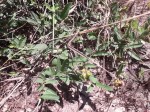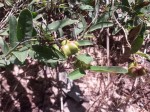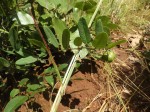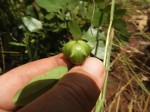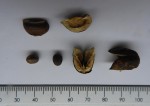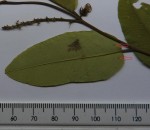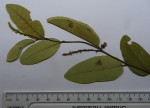| Home | > | List of families | > | Euphorbiaceae | > | Sclerocroton | > | oblongifolius |
Sclerocroton oblongifolius
Selected images: Click on each image to see a larger version and details of the record View all images (7)
Habit
Degraded miombo woodland on Kalahari sand
Lubinda Village, Kaoma Distr., Western Prov.
Feb 2021
Photo: Nick Wightman
Fruit
Degraded miombo woodland on Kalahari sand
Lubinda Village, Kaoma Distr.
Feb 2021
Photo: Nick Wightman
Fruit
Degraded miombo woodland on Kalahari sand
Lubinda Village, Kaoma Distr.
Feb 2021
Photo: Nick Wightman
Fruit
Degraded miombo woodland on Kalahari sand
Lubinda Village, Kaoma Distr.
Feb 2021
Photo: Nick Wightman
Seeds
Degraded miombo woodland on Kalahari sand
Lubinda Village, Kaoma Distr.
Apr 2021
Photo: Nick Wightman
Leaves
Open scrubland next to livestock paddock area on Kalahari sandd
Mwenda Village, Kakanda, Kaoma Distr.
Apr 2021
Photo: Nick Wightman
Inflorescence
Open scrubland next to livestock paddock area on Kalahari sandd
Mwenda Village, Kakanda, Kaoma Distr.
Apr 2021
Photo: Nick Wightman
Specimen citations: Display citations Detailed records: Display species records QDS maps by: Google Maps Point records by Google Maps
Species details: Click on each item to see an explanation of that item (Note: opens a new window)
| Synonyms: |
Excoecaria oblongifolia Müll. Arg. Sapium oblongifolium (Müll. Arg.) Pax Sapium suffruticosum Pax. |
| Common names: | |
| Frequency: | Locally common |
| Status: | Native |
| Description: |
Monoecious glabrous subshrub with one or more erect simple or sparingly branched stems 20-30(60) cm tall growing from a slender horizontal woody rootstock; leaves petiolate, petioles 2-9 mm long, leaf blades (1.5)3-6(8) x (0.5)1-3.5 cm, usually oblong and parallel-sided, sometimes oblong-lanceolate with sides not parallel, subacute to obtuse or retuse at the apex, rounded or truncate at the base, margins subentire or shallowly serrate with forward directed teeth, with 1-2 glands towards the base and sometimes also glandular near the margin towards the apex and elsewhere, thinly coriaceous with 8-15 pairs of lateral nerves slightly prominent beneath and scarcely so above; stipules 2-7 mm long, linear and laciniate at the base but otherwise entire, ciliate, deciduous; inflorescence terminal on the main axis often overtopped by a succession of lateral shoots or sometimes leaf opposed, (1)2-4(7) cm long with a peduncle up to 1.5 cm long, all male or with 1(2) female flowers at the base; male bracts broad, encircling half the axis and often somewhat 3-lobed with broadly triangular lobes, acute and irregularly denticulate, ciliolate and fleshy at the base, glandular within, 3(5)-flowered; male flowers with pedicel 1 mm long, calyx lobes 3, 0.5-1 mm long, ovate and irregularly denticulate-ciliolate, yellowish-green; female bracts rather more deeply 3-lobed than male bracts; female flowers with pedicels 2-4 mm long, extending to 7-10 mm in fruit, calyx lobes larger than in male flowers and with alternating sessile glands, ovary 2 mm in diameter, 3-lobed with each lobe bearing 2 triangular-lanceolate appendages 1-1.5 mm long, styles 3, 4 mm long and connate at the base; fruit 1.2 x 1.6 cm, green with reddish or purplish tinged to dark purplish-brown, 3-lobed, septicidally dehiscent in 3 bivalved cocci, each valve bearing a triangular appendage 1-2 mm long; seeds 6-7 x 4-5 mm, ovoid-ellipsoid, smooth, shiny, pale grey mottled blackish, ecarunculate. |
| Type location: |
Angola |
| Notes: | |
| Derivation of specific name: | oblongifolium: with oblong-shaped leaves |
| Habitat: | On Kalaharia Sands in ground layer of miombo and mixed deciduous woodlands, also on dambo margins under Parinari, Isoberlinia, Julbernardia, and Brachystegia |
| Altitude range: | 1000 - 1060 m |
| Flowering time: | Sep - Feb |
| Worldwide distribution: | Angola, DRC and Zambia |
| Zambian distribution (Flora Zambesiaca): | B,W,S |
| Zambian distribution (Provinces): | Nw,S,W |
| Growth form(s): | Shrub under 2 m. |
| Endemic status: | |
| Red data list status: | |
| Insects associated with this species: | |
| Spot characters: | Display spot characters for this species |
| Content last updated: | Monday 17 May 2021 |
| Literature: |
Radcliffe-Smith, A. (1996). Euphorbiaceae Flora Zambesiaca 9(4) Page 320. as Sapium oblongifolium |
Other sources of information about Sclerocroton oblongifolius:
External websites:
African Plants: A Photo Guide (Senckenberg): Sclerocroton oblongifoliusBHL (Biodiversity Heritage Library): Sclerocroton oblongifolius
EOL (Encyclopedia of Life): Sclerocroton oblongifolius
GBIF (Global Biodiversity Information Facility): Sclerocroton oblongifolius
Google: Web - Images - Scholar
iNaturalist: Sclerocroton oblongifolius
IPNI (International Plant Names Index): Sclerocroton oblongifolius
JSTOR Plant Science: Sclerocroton oblongifolius
Mansfeld World Database of Agricultural and Horticultural Crops: Sclerocroton oblongifolius
Plants of the World Online: Sclerocroton oblongifolius
Tropicos: Sclerocroton oblongifolius
Wikipedia: Sclerocroton oblongifolius
| Home | > | List of families | > | Euphorbiaceae | > | Sclerocroton | > | oblongifolius |
